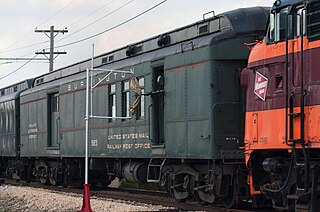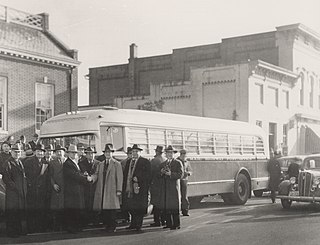The Railway Mail Service of the United States Post Office Department was a significant mail transportation service in the US from the mid-19th century until the mid-20th century. The RMS, or its successor the Postal Transportation Service (PTS), carried the vast majority of letters and packages mailed in the United States from the 1890s until the 1960s.
A ferry is a watercraft that carries passengers, and sometimes vehicles and cargo, across a body of water. A small passenger ferry with many stops, such as in Venice, Italy, is sometimes called a water taxi or water bus.

A steamboat is a boat that is propelled primarily by steam power, typically driving propellers or paddlewheels. Steamboats sometimes use the prefix designation SS, S.S. or S/S or PS ; however, these designations are most often used for steamships.

Lake Winnipesaukee is the largest lake in the U.S. state of New Hampshire, located in the Lakes Region at the foothills of the White Mountains. It is approximately 21 miles (34 km) long (northwest-southeast) and from 1 to 9 miles wide (northeast-southwest), covering 69 square miles (179 km2)—71 square miles (184 km2) when Paugus Bay is included—with a maximum depth of 180 feet (55 m). The center area of the lake is called The Broads.

Postal history is the study of postal systems and how they operate and, or, the study of the use of postage stamps and covers and associated postal artifacts illustrating historical episodes in the development of postal systems. The term is attributed to Robson Lowe, a professional philatelist, stamp dealer and stamp auctioneer, who made the first organised study of the subject in the 1930s and described philatelists as "students of science", but postal historians as "students of humanity". More precisely, philatelists describe postal history as the study of rates, routes, markings, and means.

A seaplane is a powered fixed-wing aircraft capable of taking off and landing (alighting) on water. Seaplanes are usually divided into two categories based on their technological characteristics: floatplanes and flying boats; the latter are generally far larger and can carry far more. Seaplanes that can also take off and land on airfields are in a subclass called amphibious aircraft, or amphibians. Seaplanes were sometimes called hydroplanes, but currently this term applies instead to motor-powered watercraft that use the technique of hydrodynamic lift to skim the surface of water when running at speed.

A combine car in North American parlance, most often referred to simply as a combine, is a type of railroad car which combines sections for both passengers and freight.

The 20th Century Limited was an express passenger train on the New York Central Railroad (NYC) from 1902 to 1967. The train traveled between Grand Central Terminal in New York City and LaSalle Street Station in Chicago, Illinois, along the railroad's "Water Level Route".

In Canada and the United States, a railway post office, commonly abbreviated as RPO, was a railroad car that was normally operated in passenger service as a means to sort mail en route, in order to speed delivery. The RPO was staffed by highly trained Railway Mail Service postal clerks, and was off-limits to the passengers on the train.
The Federal Express was an overnight named passenger train run by the Pennsylvania Railroad and the New York, New Haven and Hartford Railroad between Washington, DC's Union Station and Boston, Massachusetts's South Station from 1912 to 1971. At different times, its route has taken it across the Hudson River via a car float between Port Morris and Jersey City, the Poughkeepsie Bridge, and finally the Pennsylvania Tunnel and Terminal Railroad. The final routing was identical to today's high-speed Northeast Corridor.

The term highway post office refers to brightly colored red, white and blue buses used to carry mail to multiple areas over wide distances.
Terminal railway post offices were sorting facilities which were established by the Railway Mail Service to speed the distribution of parcel post. These offices were usually located in or near railroad stations in major cities or junction points. Terminal railway post offices operated generally from 1913-1914 into the mid-1960s, before their function was absorbed by post office sectional centers.

From the 1880s until well into the 1950s, virtually all long-distance transportation of United States Mail was performed by the railroads. Specially equipped railway post office (RPO) cars were a part of most passenger trains, the cars staffed by highly trained railway postal clerks who sorted mail as the train sped along its route. The growth of this mail distribution network paralleled the expansion of the railroads, allowing mail to be exchanged between routes at junction points where two railroads crossed or shared passenger terminals.
The Postal Transportation Service (PTS) was the renamed successor to the Railway Mail Service of the United States Post Office Department from October 1, 1949. Although this branch of the service had been in charge of all transit mail, some parts had little to do with railroads, even though they were still the most important part of the service. In 1950, of the 32,000 clerks assigned to the PTS, only about 16,000 actually worked on trains. The remainder were in terminals, transfer offices, Air Mail Facility, Highway Post Offices (HPO), administrative offices, etc. Boat Railway Post Office, Streetcar Railway Post Offices, and the Seapost Service had already been discontinued. The name of the Chief Clerk's office was changed to District Superintendent's office.
Streetcar railway post office (RPO) routes operated in several major USA cities between the 1890s and 1920s. The final route was in Baltimore, Maryland. The Mobile Post Office Society, Affiliate 64 of the American Philatelic Society, has published monographs detailing the operational history of each route.

J. W. Westcott II is a boat known for its delivery of mail to ships while they are underway. It operates out of Detroit, Michigan, and is the only floating ZIP Code in the United States.

The era of steamboats on the Arrow Lakes and adjoining reaches of the Columbia River is long-gone but was an important part of the history of the West Kootenay and Columbia Country regions of British Columbia Canada. The Arrow Lakes are formed by the Columbia River in southeastern British Columbia. Steamboats were employed on both sides of the border in the upper reaches of the Columbia, linking port towns on either side of the border, and sometimes boats would be built in one country and operated in the other. Tributaries of the Columbia include the Kootenay River which rises in Canada, then flows south into the United States, then bends north again back into Canada, where it widens into Kootenay Lake. As with the Arrow Lakes, steamboats once operated on the Kootenay River and Kootenay Lake.

The Baltimore Steam Packet Company, nicknamed the Old Bay Line, was an American steamship line from 1840 to 1962 that provided overnight steamboat service on Chesapeake Bay, primarily between Baltimore, Maryland, and Norfolk, Virginia. Called a "packet" for the mail packets carried on government mail contracts, the term in the 19th century came to mean a steamer line operating on a regular, fixed daily schedule between two or more cities. When it closed in 1962 after 122 years of existence, it was the last surviving overnight steamship passenger service in the United States.

Packet boats were medium-sized boats designed for domestic mail, passenger, and freight transportation in European countries and in North American rivers and canals, some of them steam driven. They were used extensively during the 18th and 19th centuries and featured regularly scheduled service. Steam driven packets were used extensively in the United States in the 19th century on the Mississippi and Missouri rivers, supplying and bringing personnel to forts and trading posts.
Mail jumping is a type of mail delivery. The person doing the mail jumping is transported on a body of water by a boat. The person jumps off the boat onto a dock, places incoming mail in a mailbox, retrieves outgoing mail, and jumps back onto the boat. The boat continues to move at a slow and steady pace while the mail jumper is jumping.













